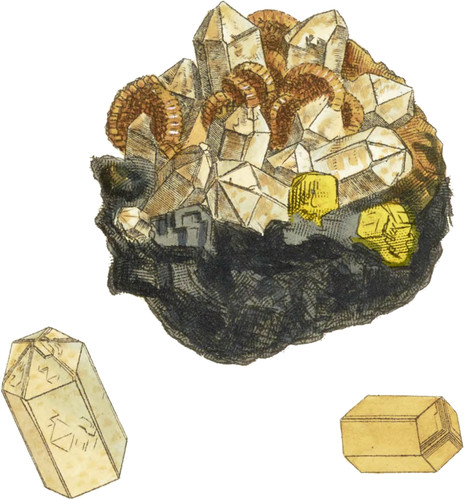 Enlarge
Enlarge
British Mineralogy
Crystallized Quartz
- Div. 1. Crystallized.
I place this as a most curious example of Quartz new to the mineralogical writers, the six vertical edges of the columns of the crystals being truncated, doubling the number of the faces, as well as those of the pyramid, which also show the manner of the nuclei accumulating to form various sportive modifications; and some of these plates meeting in seams, as I have called them, tab. 317, distinctly show their nature. Another curiosity attached to this group is a rotate accumulation of the columnar garnet-formed Carbonate of Iron or Brown spar.
Dr. Turton has long deserved my best acknowledgements, as well as those of the public, not only for his literary talents in the translation of Linnæus’s Systerma Naturæ, but in his other endeavours to assist in the general knowledge of Natural History; nor does he omit to collect specimens that are useful to those engaged in pourtraying any particular branch. Among many other kindnesses I am glad to acknowledge the present most valuable specimen, for its novelty and very instructive formation. I should think it were a loss to the public, in a work that is to serve in many instances instead of an expensive cabinet, to omit the whole specimen, although more really valuable than glaring; and besides, a book of crystals merely cannot be so valuable, and can convey no idea of the specimen it was taken from, and which it ought to elucidate.
The right hand middle figure shows the Quartz crystal magnified, and the left hand one shows a crystal detatched from the group of Garnet-like crystals of Carbonate of Lime.
The Quartz is extremely rich externally with iridescent colours; but this is lost in smallness.

